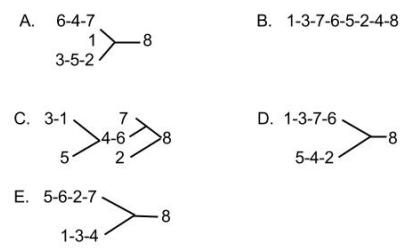
A. trace elements.
B. grass roots.
C. burrowing insects.
D. moles.
E. earthworms.
A. As tissue X develops it secretes something that inhibits the
development of tissue Y.
B. As tissue X develops it secretes something that induces tissue Y to
develop.
C. Tissue X secretes RNA which changes the development of tissue Y.
D. As tissue X develops it secretes something which slows down growth
of tissue X.
E. Rates of development in tissue X and tissue Y are controlled by the
pituitary.
A. Cooling the medium from 20°C to 10°C
B. Changing the pH of the medium from 7.0 to 6.5
C. Moving the protozoan from a Syracuse dish to a ten-gallon aquarium
D. Transferring the protozoan from a lighted environment to a dark
environment
E. Transferring the protozoan from pond water to sea water
What must be assumed if the results of this experiment are to be
considered valid?
A. Endoderm cells usually form the gonads.
B. Ectoderm cells become gametes.
C. Gonads are comprised of cells from various parts of the embryo.
D. The presence of stained cells indicates that they actively move.
E. The vital stain does not affect the cells' functions.
A. It is the basis for quantitative determination of small amounts of
growth-promoting substances.
B. It made possible the isolation and exact identification of auxin.
C. It is the basis for the experimental support for the hypothesis that IAA
is auxin.
D. It demonstrated polar movement of auxins.
E. It made possible the discovery that roots respond differently than do
shoots to different quantities of IAA.
A. Analyze the cells chemically to see if they contain the chemical
compound in question.
B. Look at living cells with a phase contrast microscope.
C. See if any other report of the organelle exists in previous literature.
D. Use different electron microscopic preparation procedures on similar
cells and see if the organelle is present.
E. Use the same procedure as the electron microscopist used on many
different cells to see if they have the organelle.
2. As environments change, selective factors will be different
3. More offspring are produced than the ecologic niche can support.
4. The best adapted forms tend to survive and reproduce in greater
numbers than the less well adapted.
5. Members of any species vary widely, some being well adapted, others
poorly adapted to their environments.
6. Adaptive characteristics are passed from generation to generation
by heredity.
7. Mutations produce new characteristics (post-Darwinian).
8. New species are produced when new selective factors preserve different
characteristics.
The best sequencing of these propositions in a logical construction of
the natural selection theory is: A. B. C. D. E.
